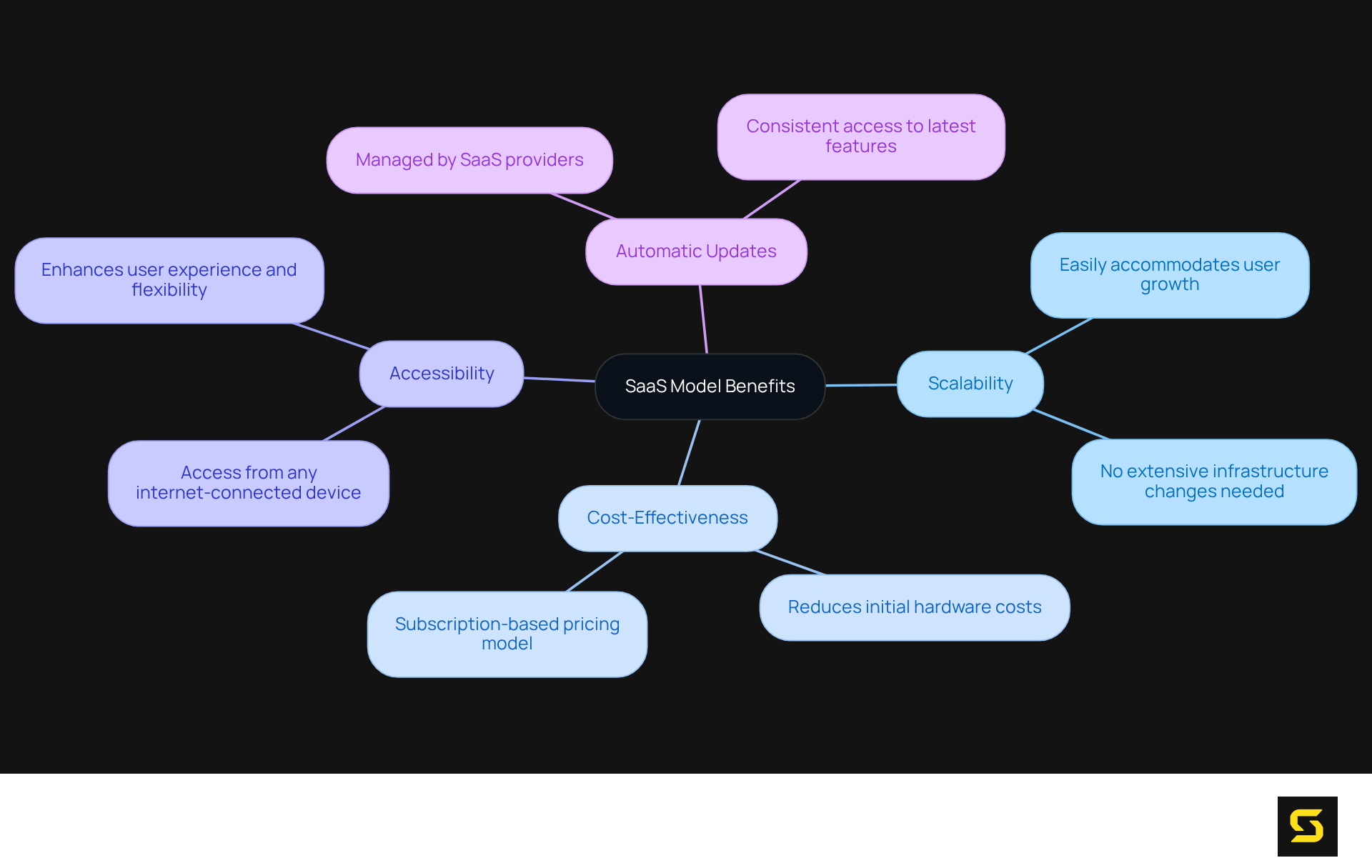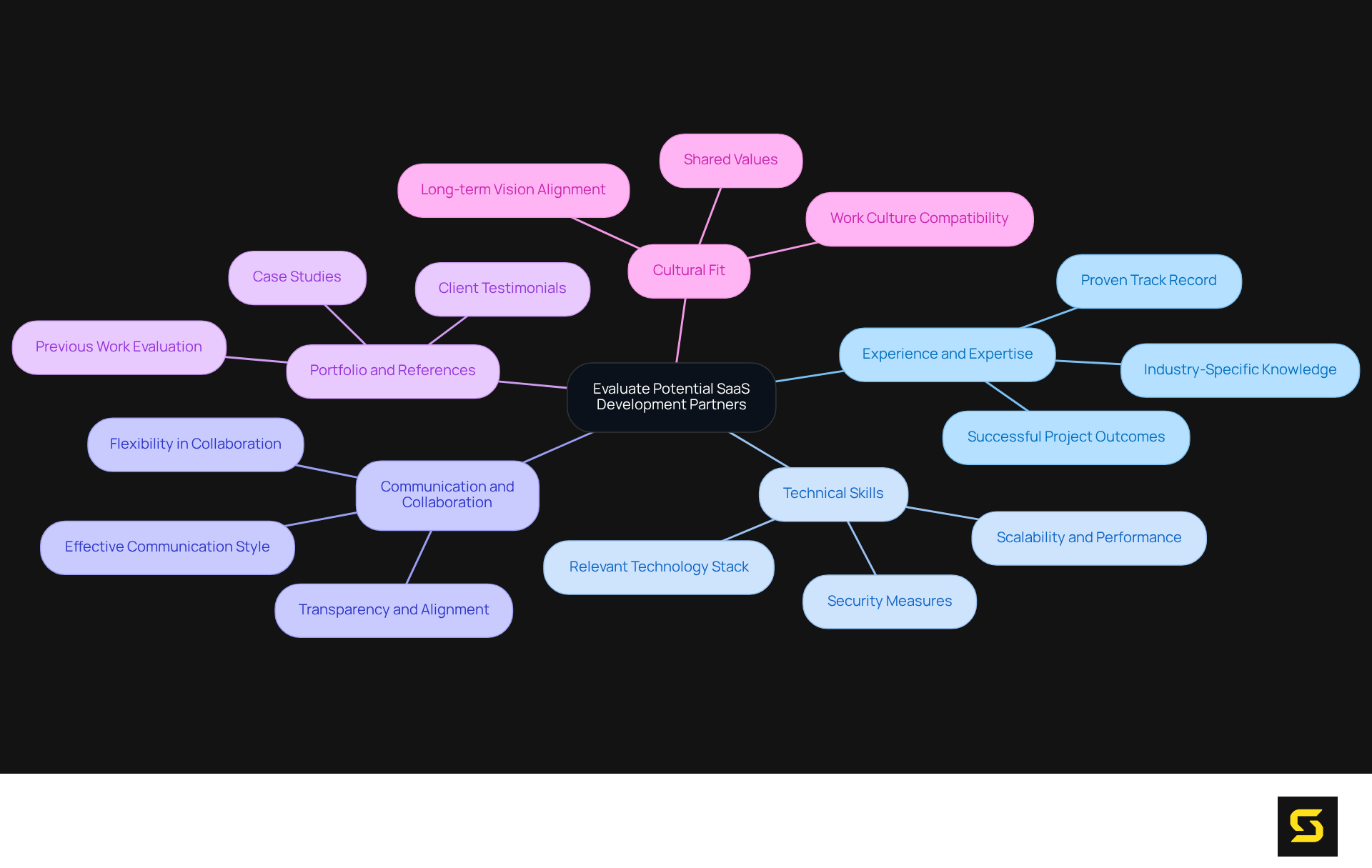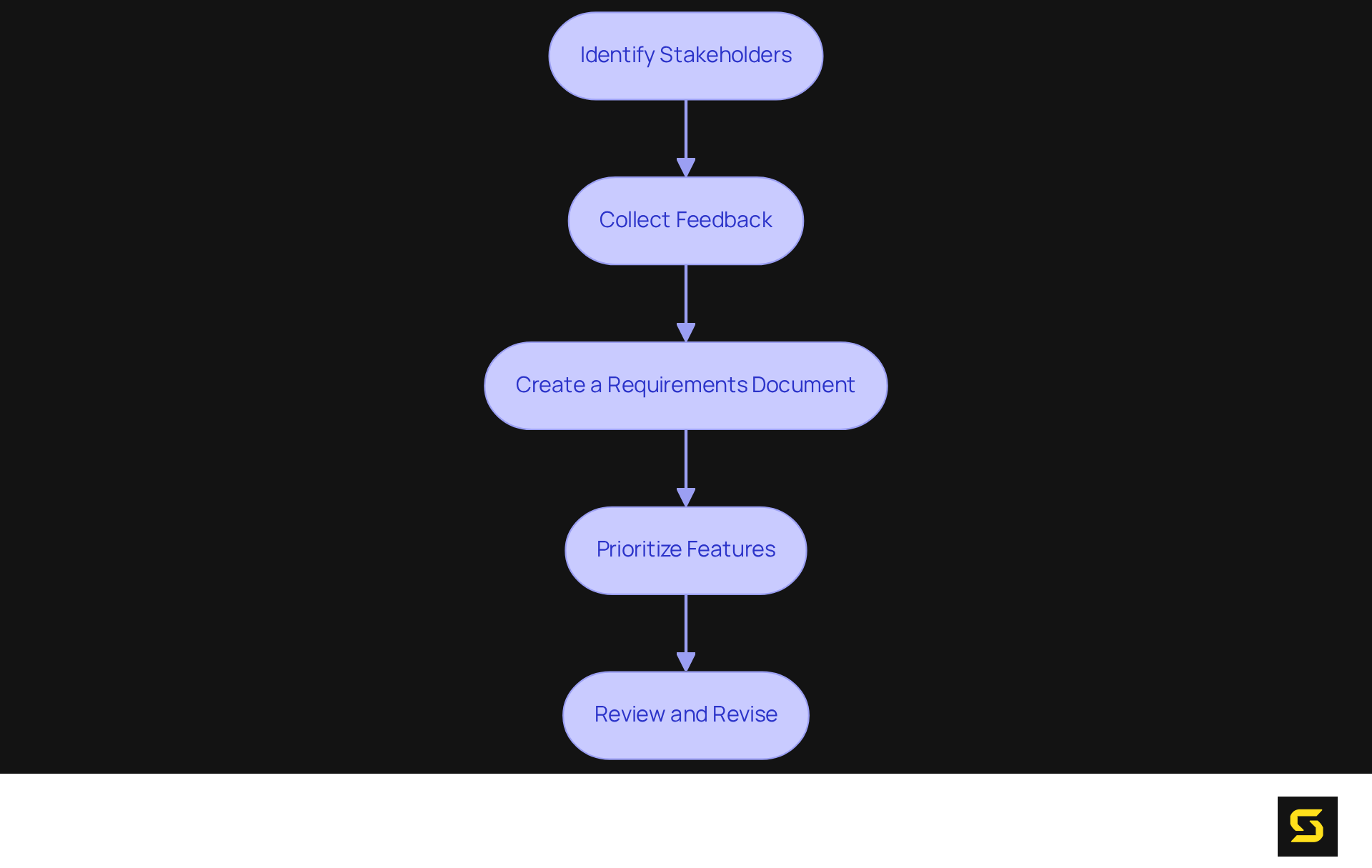Overview
For product owners, four essential SaaS development services stand out:
- Understanding the SaaS model and its benefits
- Evaluating potential development partners
- Defining project requirements
- Assessing technology stacks and methodologies
These services are not just important; they are crucial for ensuring successful software initiatives. By aligning objectives, selecting the right partners, clearly outlining expectations, and leveraging appropriate technologies, product owners can significantly enhance their product's success in a competitive market. Embrace these services to establish a solid foundation for your software projects and drive impactful results.
Introduction
The emergence of Software as a Service (SaaS) has fundamentally transformed the landscape of software development for businesses, presenting unmatched scalability, cost-effectiveness, and accessibility. For product owners, unlocking the full potential of SaaS necessitates a profound understanding of critical development services that can streamline projects and elevate outcomes. Yet, the challenge lies in navigating the vast array of options and ensuring the selection of the right partners and strategies to circumvent common pitfalls. What essential services can propel a SaaS project from concept to successful implementation?
Understand the SaaS Model and Its Benefits
The Software as a Service (SaaS) model offers significant advantages that can profoundly impact a product's success. These key advantages include:
- Scalability: SaaS applications effortlessly scale to accommodate expanding user bases without necessitating extensive infrastructure changes.
- Cost-Effectiveness: By eliminating the need for on-site hardware and maintenance, SaaS reduces initial costs and facilitates consistent subscription-based pricing.
- Accessibility: Users can access software services from any device with an internet connection, which enhances flexibility and user experience.
- Automatic Updates: SaaS providers manage updates and maintenance, ensuring that users consistently benefit from the latest features and security enhancements.
Understanding these advantages empowers product owners to make informed decisions regarding their software strategies, aligning their objectives with the capabilities of saas development services.

Evaluate Potential SaaS Development Partners
When evaluating potential SaaS development partners, it is essential to consider several key criteria that will ensure successful collaboration:
- Experience and Expertise: It is crucial to seek partners with a proven track record in SaaS development, particularly those who have successfully delivered solutions within your industry. Organizations that have navigated comparable challenges can provide valuable insights and best practices, ultimately improving outcomes. Notably, a recent survey reveals that 40% of SaaS companies plan to invest more in outsourcing, highlighting the importance of selecting experienced partners.
- Technical Skills: Ensure that the partner possesses the necessary expertise in the technology stack that aligns with your requirements. This specialization is vital for developing capable of accommodating increasing user loads without sacrificing performance or security.
- Communication and Collaboration: Assess the partner's communication style and their willingness to collaborate. Effective communication is paramount for achieving success, as it fosters transparency and alignment on objectives throughout the development process. Industry experts emphasize that when it comes to SaaS development services, expertise and experience are paramount.
- Portfolio and References: Scrutinize their previous work and client testimonials to evaluate their capabilities and reliability. A robust portfolio showcases their ability to deliver high-quality solutions tailored to specific business needs. For instance, companies that have successfully executed similar initiatives serve as benchmarks for potential partners.
- Cultural Fit: It is important to ensure that the partner's values and work culture resonate with your organization. A suitable cultural alignment fosters a constructive working relationship, which is essential for managing the complexities of software-as-a-service creation. Common pitfalls include selecting a partner without a shared vision for long-term objectives, which can lead to miscommunication and delays.
By thoroughly assessing these elements, product owners can select a development partner that not only meets their technical requirements but also contributes positively to the overall success of their software endeavor. This comprehensive assessment process can yield better results, enhance teamwork, and ultimately lead to a more successful software product.

Define Project Requirements and Expectations
Defining clear project requirements is crucial for the success of SaaS projects and involves several key steps:
- Identify Stakeholders: Engage all relevant stakeholders to gather diverse perspectives, ensuring that all needs are considered. Successful stakeholder involvement is crucial; indeed, 62% of successfully completed initiatives had supportive sponsors, highlighting the importance of guidance and alignment. As noted, "Stakeholder engagement is the most valuable PM process."
- Collect Feedback: Conduct surveys or interviews with potential participants to understand their pain points and expectations. ; organizations that prioritize it see improved outcomes. Ignoring feedback from users can lead to challenges, as 80% of organizations report spending at least half their time on rework when establishing deadlines.
- Create a Requirements Document: Develop a comprehensive document that outlines functional and non-functional requirements, user stories, and acceptance criteria. This document serves as a reference point throughout the initiative lifecycle, ensuring clarity and focus. Notably, 70% of projects globally fail due to issues such as inaccurate requirements and shifting project objectives, underscoring the necessity for a well-defined requirements document.
- Prioritize Features: Utilize techniques like MoSCoW (Must have, Should have, Could have, Won't have) to prioritize features based on business value and user needs. Prioritization is essential for managing scope and aligning development efforts with strategic goals.
- Review and Revise: Regularly review the requirements with stakeholders to ensure alignment and make adjustments as necessary. Ongoing involvement with stakeholders can mitigate risks and enhance adaptability. The absence of specific objectives is the most frequent reason for failure in initiatives, impacting 37% of endeavors, which emphasizes the importance of continuous communication.
By adhering to these steps, product owners can establish a robust foundation for their software initiative, ensuring that the team possesses a clear understanding of expectations and is well-prepared to deliver a successful outcome using SaaS development services.

Assess Technology Stack and Development Methodologies
When evaluating the technology stack and development methodologies for your SaaS project, it is essential to consider several key factors:
- Technology Stack: Choose a stack that guarantees scalability, security, and performance. The MERN stack (MongoDB, Express.js, React, Node.js) stands out as a preferred option due to its adaptability and strong community support, which facilitates rapid creation and deployment.
- Development Methodologies: Assess methodologies such as Agile, Lean, or Waterfall based on your specific requirements. Agile is often favored for its iterative approach, fostering continuous feedback and adaptation, which leads to higher success rates in SaaS development. Indeed, Agile projects have demonstrated success rates that are 60% higher than those employing Waterfall, according to the Standish Group.
- Integration Capabilities: Confirm that the selected technologies can seamlessly integrate with third-party services and APIs, enhancing your application’s overall functionality and enabling future scalability. Leveraging scalable infrastructure from cloud service providers like AWS, Google Cloud, and Microsoft Azure can significantly boost integration capabilities.
- Security Features: Prioritize technologies that provide robust security features to safeguard data and ensure compliance with industry regulations. With over 60.8% of expensed SaaS applications rated as having a 'Poor' or 'Low' , this aspect is vital for maintaining user trust. As Brontë Schmit noted, "Unauthorized AI apps create major security vulnerabilities, compliance issues, and data protection risks."
- Team Expertise: Assess your team's familiarity with the chosen technologies to ensure efficient development and ongoing maintenance. A knowledgeable team can effectively navigate challenges, keeping the project aligned with its goals.
By thoughtfully considering these elements, product owners can make informed decisions that significantly contribute to the long-term success of their SaaS development services. For instance, companies that focus on continuous value delivery by tracking user engagement and feedback are better positioned to meet the dynamic needs of their customer base, resulting in enhanced satisfaction and retention.

Conclusion
The exploration of essential SaaS development services underscores the critical components that product owners must consider to ensure their software's success. By grasping the inherent benefits of the SaaS model—such as scalability, cost-effectiveness, and accessibility—product owners can strategically align their initiatives with the capabilities of SaaS development services. This alignment is pivotal for navigating the complexities of modern software development.
Key insights from this discussion highlight the necessity of:
- Selecting the right development partners
- Defining clear project requirements
- Carefully assessing technology stacks and methodologies
Evaluating potential partners based on their experience, technical skills, and cultural fit can significantly enhance collaboration and improve project outcomes. Furthermore, establishing robust project requirements and employing appropriate technology stacks can lay the groundwork for a successful SaaS initiative.
Ultimately, embracing these best practices transcends mere project execution; it fosters innovation and adaptability in a rapidly evolving digital landscape. By prioritizing informed decision-making and continuous stakeholder engagement, product owners can effectively position their SaaS products for sustained success and growth. The journey of SaaS development is ongoing, and leveraging these insights will lead to more effective strategies and enhanced user experiences in the future.
Frequently Asked Questions
What is the SaaS model?
The Software as a Service (SaaS) model is a software distribution method where applications are hosted by a service provider and made available to users over the internet.
What are the key benefits of the SaaS model?
The key benefits of the SaaS model include scalability, cost-effectiveness, accessibility, and automatic updates.
How does scalability work in the SaaS model?
SaaS applications can easily scale to accommodate an expanding user base without requiring extensive changes to the underlying infrastructure.
Why is SaaS considered cost-effective?
SaaS is cost-effective because it eliminates the need for on-site hardware and maintenance, reducing initial costs and allowing for consistent subscription-based pricing.
What does accessibility mean in the context of SaaS?
Accessibility in SaaS means that users can access software services from any device with an internet connection, enhancing flexibility and user experience.
How are updates and maintenance handled in SaaS?
In the SaaS model, providers manage updates and maintenance, ensuring that users always have access to the latest features and security enhancements.
How can understanding SaaS benefits help product owners?
Understanding the advantages of SaaS enables product owners to make informed decisions about their software strategies, aligning their objectives with the capabilities of SaaS development services.





